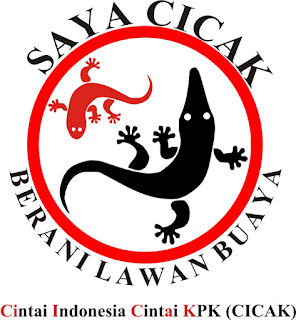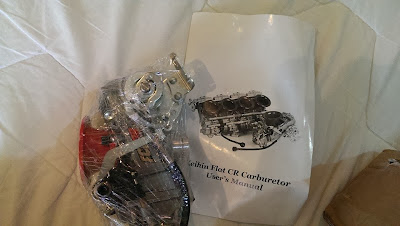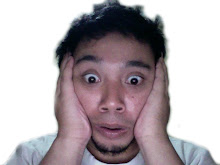The Behind the Scenes Story
On the afternoon of July 6 2009, ten of us were a little surprised at the meeting invitation from these gentlemen, as it had been one month since our tiny office had became more crowded with their presence. We were happy since their opinions would help to increase our knowledge, but if only we’d known at the time that Antasari had been arrested and was being processed for his alleged involvement in a murder. I myself had argued with some friends the day before about the “murder scenario”, and imagined the associated “conspiracy theory”. At least one of the office glasses was already full of marker pens and diagrams. The only conclusion at the time was to “follow the money instead of focusing on the perpetrator.” That afternoon, the gentlemen looked more tense and serious than ever. I felt honored to have been invited to meet with them.
“We have to start moving!” “People outside need to know the real situation, otherwise the Corruption Eradication Commission (KPK) could soon disappear”, said one of them.
“Tomorrow there will be an attempt by the police to detain Chandra, and today we have no other choice but at the very least, we can’t stay silent,” he said again, thrusting his TEMPO magazine with an image of a face I didn’t recognize.
All I remember was that the person in the image had his hands on his hips. Although I didn’t know him, I didn’t like his style; I thought it was a bit arrogant. After I read more of the article, blood rushed to my head and although his words weren’t addressed to me, for some reason it felt like my dignity had been trampled. How could such person exist today? That was the first question that came to my head, and when I went back to check, it turned out that there are many more people like him in our country. Instantly, my stomach felt queasy.
“Now we have a reason to fight,” said a white-haired gentleman.
“We can write and immediately publish posts on several blogs, mailing lists, and websites; basically anywhere that can be accessed by the common person, who can then read about what actually happens”.
What did really happen? Was the second question that popped into my head. My thoughts were still stuck on Antasari’s murder case, until I realized that I still hadn’t eaten lunch.
“Write about the Bank Century corruption case, and the effort to weaken the Corruption Eradication Commission,” he repeated.
“What if we write from another angle?” I suddenly interrupted; a bad habit which is hard to shake. “What if we write by putting more focus on the gecko?” I was getting out of control. It seemed like everyone in the room was confused.
“I don’t know what your exact feelings are over this article, but in my eyes, what is meant by the gecko here isn’t only limited to the KPK”.
“We are all geckos in his eyes”.
“If the Chairman of the KPK is considered a gecko by him, then what are we - the ordinary people? Ants? Or germs?”
If I were any good at writing, I would write about the snobbery of the Crocodile and we could include another article about corruption to strengthen the reason why we’re angry”.
“He’s already corrupt, claiming to be a winner, and it’s so insulting”. I had completely lost control. For some reason, it looked like my last words were in fact true (which is rare) because the attendees seemed more receptive.
“OK then, try to write now and in an hour we will meet again,” said a tall gentleman with a long nose.
“Bro, you draw the cartoons! Some pictures of crocodiles attacking the KPK office!”
“Yes, I will try” I said, while beginning to play around with Corel Draw.
Then the gentlemen stepped out of the meeting room.
“Oh, I forgot to tell you”, said the white-haired gentleman.
“There is information saying that this office has been tapped by police as well, so be careful about what you say”, he said with a smile.
It was like being struck by lightning, my friends and I looked at each other in confusion, fear, anxiety, and wonder, but eventually, we laughed. Perhaps we were simply unwinding, laughing as though we were exhausted after being chased by dogs but then managed to escape—laughing with a feeling of anxiety and wariness. My brain was spinning, I started to draw a crocodile, then a building, then a gecko. It was indeed an ugly picture. If I were a school art teacher, I’d give a score of 3 for it. Then suddenly, I had an idea after I read the article again and saw the Apple logo on the computer. What we needed was a logo which depicted the resistance of a gecko against a crocodile. I had 30 minutes to draw, and I was sure that the result wouldn’t be good. Inspired by the symbol of YingYang, I created a circular image of a lizard and a crocodile in a face-to-face encounter and wrote in large letters; “I am a gecko, daring to fight against a crocodile”.
It’s possible that a logo/symbol would be more easily accepted, as opposed to a cartoon or caricature, since a logo doesn’t need to be understood, it’s more flexible in terms of being published in various media such as posters, t-shirts etc, and more importantly, it allows for freedom of interpretation. All my friends in the room approved the image I proposed. One hour was up. I was still not satisfied, far from it. Finally, the article was also finished and we decided on a phrase the word CICAK could stand for (gecko); “Cintai Indonesia, Cintai KPK” (Love Indonesia, Love the KPK). It did seem a little self-imposing, but there was no other better option so we all agreed to use it.
“Don’t forget to use the “gecko” logo as your “profile picture”. Share it with everyone we know and invite them to use it as well; as many people as we can,” I said to all present in the room.
The article was posted, the image went up. I was still far from satisfied with it. Because I was still curious when I arrived home, I tried to make some other logos. After 2.30 am, I had finished a logo with an image of a red gecko pointing its finger with the same writing; “I am a gecko”. I made the image my “profile picture” on Facebook, replacing my initial logo before finally going to sleep. The next morning, I was in high spirits going to the office with the objective of telling my other friends to use the new logo, rather than the old logo of Ying-Yang.
“Bro, your image has already spread everywhere”, said a friend who was sitting cross-legged in front of the office.
“In your new image, the gecko looks more like a large lizard. No gecko has spots on its body,” he said with a laugh. It was the same response when I entered the office.
“Was it you who drew the logo?”
“It’s already spread.”
I hurriedly opened my laptop, and went straight onto my Facebook account. Almost everyone I knew had already replaced their “profile picture” with the old logo. I was too late.
“Why did you make a new logo anyway?”
“It will make people confused about which one to use,” said a friend.
“Let it be, the more options there are, the more people will use them, since they may not like the old logo just like me”.
“We are democratic, aren’t we? It is not a matter of the logo, but what is represented in the logo,” I replied a little sad, since so many people had already used the old logo. In my heart, I was determined to “make another image, maybe even more”. Hopefully the images could represent what we were feeling.
“...I am a gecko, you are a gecko, we are all geckos and they are crocodiles”.
Gecko versus Crocodile” Online Campaign
There’s a clear distinction between the days before the internet era and thereafter in terms of the speed of disseminating information. A similar distinction was felt by humans about 300 years ago when the “printing press” was first discovered, and previously information could only be disseminated verbally. After printing tools were discovered, all records, discoveries and scriptures were able to be reproduced and distributed quickly. Imagine information dissemination being one thousand times larger in terms of amount and speed - that is the age of the internet.
Several characteristics determine how fast and large the effect of the spread of information can be in the virtual world, besides the technology itself, including:
- The characteristics (demographics) of internet users in the area and the time in which information is “published” in the virtual world;
- The situation/circumstances in which such information is published;
- The way information is published and disseminated.
2008 was the beginning of a new social movement. Previously, most internet users were not quite aware of how powerful the internet’s role could be in disseminating information linked with movements /mass action. The case of Gecko versus Crocodile is one of the “milestones” in the history of community movements, which was united in the common goal of “Arising, Uniting against Corruption”.
The movement was started by ten people and supported by millions in less than three months. What distinguishes the Gecko versus Crocodile movement from other online and offline movements is its technique. Prior to this campaign, most other online and offline mass movements have been one-way, while the Gecko versus Crocodile campaign opened up opportunities for anyone to contribute, either directly or indirectly, by spreading the movement’s writings, drawings, and other works, or just by clicking “like” on Facebook.
Symbols in the Gecko versus Crocodile campaign had an important role because they could be directly received and absorbed by anyone who saw them, instead of adopting a different agenda or opinion about the eradication of corruption. The symbols of the Gecko versus Crocodile campaign successfully represent most of the community’s feelings, not merely in terms of “fighting against corruption” but also in terms of fighting “against the arrogance” of government officials/authorities.
Characteristics & Demographics
Indonesia has the highest number of internet users after China and the United States, with more than 70 million users. The number of users increases every year by approximately 18 per cent from the previous year, and nearly 70 per cent of all internet users are active on “social media” (Facebook), placing Indonesia as the country with the highest number of “social media” users in the world.
One of the social characteristics of internet users in Indonesia is that their “tendency to share” is stronger than in other countries such as China and the US, where internet users are more likely to be passive. The high level of activity and interaction among internet and social media users accelerates the process of information dissemination, making information more easily accessible amongst the network of internet and social media users.
An example is the Gecko versus Crocodile campaign, which was more easily accepted by people when they saw or read it in their own friendship networks, than if they had have seen it in electronic (website) or printed media. In this circumstance, the role of “social media” is crucial.
The statement “...a gecko wants to fight against a crocodile...”, issued by the National Police Criminal Investigations Commission, degraded what was essentially an exceptionally effective trigger in quickening the public’s acceptance of the campaign, like a fire that’s been doused in gasoline, even within the police institution itself. Selecting social media to be the main form of media in the Gecko versus Crocodile campaign was not only based on the high number of social media users in Indonesia, but also on its simplicity which allows anyone who sees the campaign to invite interaction/direct response from others.
By simply replacing their profile picture and posting a “link” that explains the purpose of the logo/image of the Gecko versus Crocodile to other Facebook accounts, the campaign was able to invite tens of thousands of questions from respective social networks, which eventually resulted in people changing their profile pictures as a form of support.
The same process was repeated and continued to spread on a larger scale in a short period of time.
Situation & Circumstances
The corruption case itself might not be the only reason why the campaign triggered such a positive response, but it was certainly an integral part of the “humiliation” that arose out of the National Police Criminal Investigations Commission at the time.
Regardless of the case, there was no precedence which indicated that the Indonesian people would stay silent if they were ever insulted or denigrated. An example of another case that received a positive response is the case of Prita. Within a short period of time, Prita managed to gain a lot of support both in the virtual and real world in the form of coin collections. A key factor in the success of an online campaign is timing, and there are sometimes a variety of responses which can strengthen the spread and message of the campaign.
The case of Evan Brimob for example, was once a phenomenon in the virtual world. Evan made the statement; “police do not need people, it is people who need police” on his Facebook account. The statement spread widely just days after the Gecko versus Crocodile campaign had enlivened the internet, and gained a tremendous response from users in Indonesia at that time. Evan’s response, which may initially have been a representation of his loyalty as a member of the police, helped to reinforce the Gecko versus Crocodile campaign, like pouring gasoline on the burning fire.
Ways of Spreading Information
The online campaign probably wouldn’t have succeeded without being supported by an offline campaign, and would’ve gone nowhere if the spread hadn’t been supported by the existing mainstream media.
There are several factors that contributed towards the success of the online campaign in terms of content, including:
- The campaign’s content was simple and specific i.e. focused on a particular issue. The more simple and specific a campaign is, the easier it is accepted;
- The campaign’s content targeted more than one group of people, in order to convey a more powerful message;
- The content of the online campaign was repetitive, and delivered through either the same media or other media. Repeating the same message many times will reinforce the message, allow for improvement (updates) and open up opportunities for input from the user.
The Gecko versus Crocodile campaign managed to get the attention of dozens of local and international media outlets, both printed and electronic. It was recorded by tens of news agencies (local and international), and covered by thousands of websites and blogs. Offline support from various NGOs including Transparency International Indonesia (TII) and Indonesia Corruption Watch (ICW) in realizing the mass action ranged from declarations to action; “one million supporters of Chandra Bibit” was one of the most crucial parts of the campaign. Since the offline campaign was the only link to the online campaign, the virtual movement became a real movement.
Up to this day, the term Gecko versus Crocodile is still relevant and used whenever there is any form of public resistance against the authorities.












.jpg)






